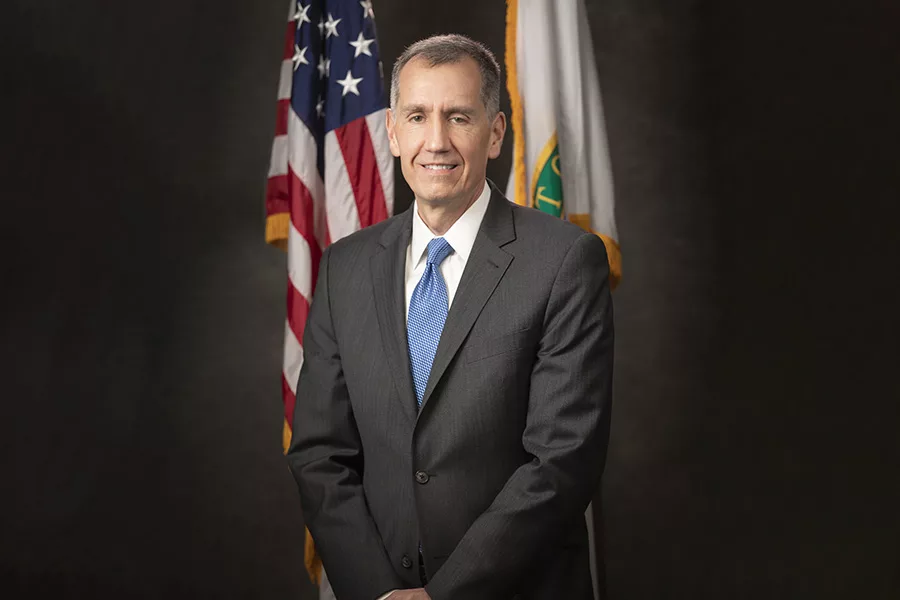
Home » Top Hanford manager announces resignation
Top Hanford manager announces resignation

Brian Vance
Courtesy DOEMarch 26, 2025
Brian Vance, who has been the U.S. Department of Energy’s leader at the Hanford site for just over six years, is resigning and will step down April 24.
Vance, who is the manager of the Richland Operations Office and Office of River Protection for DOE’s Office of Environment Management, now called the Hanford Field Office, announced his resignation in a letter sent to all site personnel on March 26.
He did not give a reason for his departure.
“I am leaving the site poised to make history later this year, when the Waste Treatment and Immobilization Plant begins to vitrify tank waste for the first time. This achievement is monumental and will represent an accomplishment that some felt would never be realized,” Vance wrote in his letter.
“Time and again we’ve proven that talented and dedicated professionals, working together as a team, can overcome obstacles and deliver great accomplishments like few other places in our nation,” he added.
A DOE spokesperson told the Tri-Cities Area Journal of Business the agency appreciates Vance's years of service and is committed to ensuring a smooth transition as he departs.
Brian Harkins was appointed as acting deputy manager, effective April 3 by outgoing Manager Brian Vance, according to a memo sent to site staff.
The agency’s No. 2 leader at Hanford, Brian Stickney, deputy manager and chief operating officer for the Hanford Field Office, announced in mid-March that he would retire Dec. 31, 2025. However, he left the site on March 26 as he is participating in the federal Delayed Resignation Program, according to DOE. That program was instituted as part of the Elon Musk-led Department of Government Efficiency’s efforts to cut the federal workforce.
Stakeholders weigh in
Vance’s sudden departure generated messages of thanks but also of concern from different stakeholders.
“I’m not sure it’s going to be a high priority with the current administration to get that position filled,” said Nikolas Peterson, executive director of watchdog organization Hanford Challenge.
Susan Coleman, chair of the Hanford Advisory Board (HAB) citizen advisory group, said in a statement to the Tri-Cities Area Journal of Business that HAB recognized Vance's engagement in the board’s mission to provide policy-level advice to the agencies in charge of the cleanup and wished him luck in his next leadership role.
David Reeploeg, vice president of federal programs at the Tri-City Development Council (TRIDEC), thanked Vance for his service and his efforts to advance cleanup at the site.
“TRIDEC will continue our strong support for Hanford cleanup, and we look forward to working with future Hanford leadership to further explore additional partnership opportunities between the Tri-City community and DOE in areas such as beneficial reuse of federal land, workforce development, and much more,” Reeploeg said in a statement.
Vance’s legacy
Vance joined DOE in 2017 and his leadership at Hanford began in February 2019 with a limited appointment as the manager of the DOE Office of Environment Management’s Richland Operations Office and Office of River Protection.
During that appointment, he aligned operations to begin treating tank waste through the Direct-Feed Low-Activity Waste (DFLAW) approach and concentrating cleanup work on the site’s central plateau, according to a release.
He was named the permanent manager of both offices in July 2020.
“Brian has guided Hanford operations with a steady hand,” said William “Ike” White, senior advisor for environmental management to the Under Secretary for Science, in 2020. “The men and women on the ground continue making great progress, and I have full confidence that Brian will continue to lead this team into the next phase, as we move towards actual tank waste treatment and cleanup completion in many areas.”
In his role, Vance is responsible for a roughly $3 billion annual budget as well as oversight of the cleanup operations conducted by 13,000 people working for federal contractors on the site.
Vance cited several accomplishments during his tenure in his resignation letter, including the removal of sludge and the grouting of the K Basins, the recently finalized holistic agreement with state Ecology officials and the Environmental Protection Agency to remediate tank waste and 11 consecutive years of treating more than 2 billion gallons of groundwater.
At the most recent meeting of the Hanford Advisory Board, he also noted progress on cold commissioning of the DFLAW process at the vitrification plant and the moving of some waste from wet to dry storage among several goals anticipated this year.
“I’ll just highlight I think we’re carrying a lot of positive momentum into 2025 as you think about all the things we’ve accomplished really over the last several years,” Vance told HAB, adding, “We get past big events like that (and) we go what’s next? Well, sometimes it’s good to remember those big events really weren’t that long ago and that momentum of the site is based on those events.”
Peterson said Vance's departure is all the more surprising and unfortunate given an upcoming big event: the vitrification plant getting near to begin operations.
“We are so close to glass,” he said, referring to the vitrification process.
Vance has more than 30 years of experience in the nuclear industry, per biographical details provided by DOE. Prior to working for the agency he held management roles for CH2M Hill Plateau Remediation Company, Westinghouse, Areva (now Framatome) and a development project to build three nuclear plants at a site in England.
He also had a 25-year career in the U.S. Navy as a nuclear-trained submarine officer, retiring as a captain in 2009.
Latest News Hanford
KEYWORDS March 2025
Related Articles
Related Products





